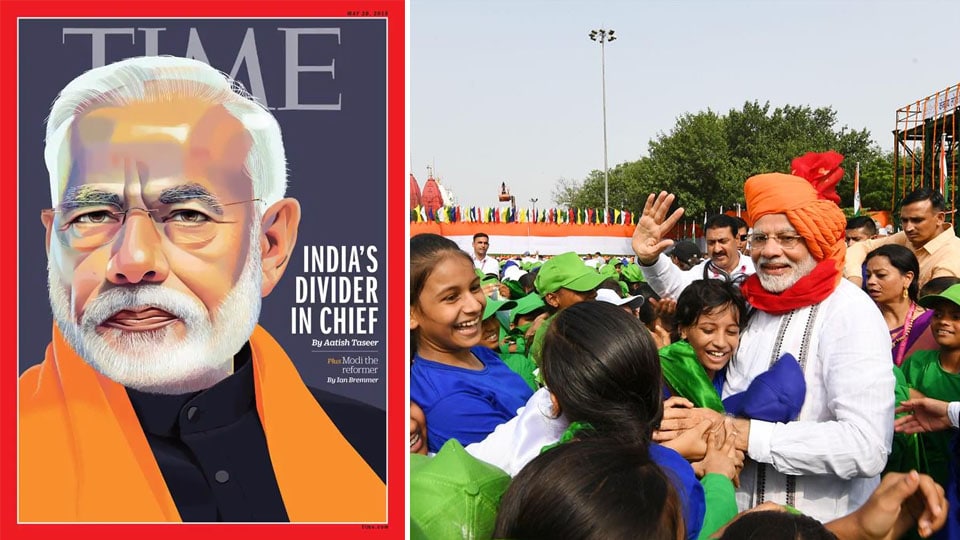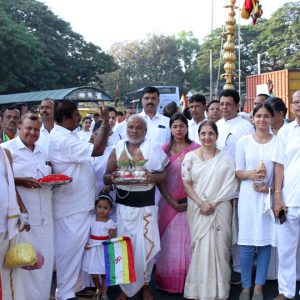
He is changing the politics and economics of India after 72 years of Independence
When the American weekly news magazine TIME dated May 20, 2019 came out with Prime Minister Narendra Modi’s photograph on the cover with the title India’s Divider In Chief, a vast majority of Modi loyalists apparently did not approve of the magazine’s presentation of Modi. Their worry was that it was published towards the last important phase of the ongoing election. I am a regular subscriber to TIME magazine for many years and it landed on my desk just yesterday. The news about this issue of TIME relating to Modi has already appeared in print and electronic media. So I was actually waiting eagerly to see the magazine, the cover of which is produced alongside.
The main article titled The Modi Era was written by a very well-known novelist and journalist of Pakistan origin Aatish Taseer, who has an Indian connection, his mother being an Indian journalist Tavleen Singh. His father was a Pakistani politician and a businessman Salmaan Taseer, a great humanist. Taseer was assassinated by his bodyguard who disagreed with his opposition to Pakistan’s ‘inhuman’ blasphemy law.
It is indeed an article written very objectively without any bias or prejudice and gives a clear picture of why and how India is undergoing a political and economic change under Modi. Until Modi came to power in 2014, India had been ruled primarily by one party — the Congress — for 54 years of the 67 years after India became free, according to the article. Now, the present election will decide whether BJP would continue to guide our country’s destiny.
The writer says that it is necessary to go back to the first season of Modi story to understand why the advent of Modi is at once an inevitability and also a calamity for India. It gives a glimpse into populism. This populism has given voice to the majority of its population among other minority communities. Apparently, it suggests that earlier during the long rule of Congress, the Hindu majority was not able to find its voice as any majority would like to.
The author explains this phenomenon beautifully in the article. Let me quote: “Nehru’s political heirs, who ruled India for the great majority of those post-independence years, established a feudal dynasty, while outwardly proclaiming democratic norms and principles. India, under their rule, was clubbish, anglicised and fearful of the rabble at the gates. In May 2014 those gates were breached when the BJP, under Modi, won 282 of the 543 available seats in the Parliament, reducing the Congress to 44 seats, a number so small that India’s oldest party no longer even had the right to lead the Opposition.”
The story, however, starts with independence. When British India was divided in 1947, Pakistan was founded as a homeland for Indian Muslims. But what about India? India did not become the homeland for Hindus and other minority communities excluding Muslims. India chose under Prime Minister Jawaharlal Nehru “not to be symmetrically Hindu.”
Strangely and paradoxically, despite the division, India had a substantial Muslim population, now more than 172 million. So Nehru bequeathed to the newly independent India an ideology called Secularism. Here too the balance of advantage went to the minorities because, “This Secularism was more than merely a separation between religion and State; In India it means equal treatment of all religions by the State.”
Naturally, some religions, for reasons of Vote Bank politics, became more equal than others, as a result, excluding the Hindu religious majority. Explaining this paradox, the article says, “Indian Muslims were allowed to keep Sharia-based family law, while Hindus were subjected to the law of the land. Arcane practices — such as the man’s right to divorce a woman by repudiating her three times and paying a minuscule compensation — were allowed for Indian Muslims, while Hindus were bound by reformed family law and often found their places of worship taken over by the Indian State.”
The way the writer has dissected the Indian political situation following 2014 elections should be an eye-opener both to the Congress party and to the other Opposition political parties including the ginger groups. This had exposed the underbelly of Democracy — Populism. Here Modi becomes the favourite of the people. People did not bother about the ideology of political parties. A great majority began doubting the sincerity of the Constitution-makers, ‘the place of minorities and its institutions, from Universities to corporate houses to the media.’
They were shown to be severely distrusted. The writer reveals what was hitherto not known as political deeds (or misdeeds) by those who ruled India for more than 55 years. Till 2014, Indians were told that providing Secularism, Liberalism and a Free Press were great achievements to be cherished. However, in 2014 with Modi’s great oratorical skills, these so-called achievements came to be seen in the eyes of many as part of a grand conspiracy in which the westernised Hindu elite, in collusion with religious minorities such as Christianity and Islam “maintained its dominion over India’s Hindu majority.” Modi’s victory was an expression of that distrust, says the article. This was the reason why Modi spoke of a “Congress-Free India.”
It is a fact that, with the rise of Modi, we see an ascendance of Hindu religious Nationalism, with the anti-minority sentiments. However BJP is taking pride in the fact that during the last five years of Modi rule, there has not been a single communal riot in a country which has a long history of “politically instigated sectarian riots.” The article says that India’s English-speaking elite represented by the Congress party are working to prevent the rise of a proud Hindu nation. According to the writer, Modi’s economic miracle, promised in 2014, has failed to materialise, while he has helped to create an atmosphere of poisonous religious nationalism in India.
Surprisingly for we Kannadigas, the article quotes our young BJP candidate from Bengaluru South Tejasvi Surya, who in his speech of rhetoric and bombast said, “If you are with Modi, you are with India. If you are not with Modi, then you are strengthening anti-India forces.”
I was amused to read what is written about Rahul Gandhi in the article. Saying that the incumbent Modi may win again, Aatish Taseer says that the “Opposition, led by Rahul Gandhi, an unteachable mediocrity and a descendant of Nehru, is in disarray.”
Likewise, the article doesn’t have any words of praise or compliment to Rahul’s sister Priyanka Gandhi Vadra too. Taseer says, “India’s oldest party has no more political imagination than to send Priyanka Gandhi to join her brother’s side.” Of course, needless to say that those who thought Priyanka Gandhi Vadra would be a match to Modi in public speech and make a dent in BJP campaign were disappointed at her performance and waning popularity.
And finally the sting is in the tail: “Modi is lucky to be blessed with so weak an Opposition — a ragtag coalition of parties, led by the Congress, with no agenda other than to defeat him.”
While what is written by Aatish Taseer is pure politics, there is another article about Modi’s economic programmes and reforms under the title India’s Best Hope for Economic Reform by Ian Bremmer. In this article, it is recalled that Modi had made extravagant promises in 2014 but could not deliver on some of them. According to Bremmer, Modi’s economic record is mixed and India has become the world’s fastest growing large economy. The article says that India needs change and Modi remains the person most likely to deliver. While Modi improved relations with China, US and Japan, his domestic development agenda has helped to improve the lives and prospects of hundreds of millions of people, which is a big accomplishment for a short period of five years as Prime Minister.
Through the GST, he has broadened the tax base and increased the revenue of the Government. As a result, his Government had more revenue to spend on development. The amount he has spent towards India’s new infrastructure seems unprecedented. More importantly, he has provided bank accounts for 300 million people who had never had them in their lives, thereby enabling them to access credits and State subsidies.
I remember in my village Kakkabe in Kodagu, marginal farmers and coffee planters were approached by the Revenue Officers, who inspected the farmland and plantation to evaluate the loss due to the heavy rains and land slips that devastated some parts of Kodagu district. The local people, from their past experience, were doubtful about receiving any compensation saying it was all a drama. However, to their pleasant surprise, the Central Government of PM Modi had transferred money directly to their bank account. This had never happened in the history of Independent India. Even the subsidy of domestic LPG cylinder is directly credited to the account of the consumer. Certainly, an effective measure by the Modi Government to protect the consumers and the beneficiaries from corrupt officials and middlemen. I hope the innocent voters would remember this kind of gesture and help from Modi Government.
Be that as it may, the article talks of the healthcare reform Modi brought about which could help a billion poor people in treating cancer and heart diseases. The article also mentions of Ujjwala Yojana scheme to help women in the countryside with cooking gas for the first time.
The article asks the question: “What does it take to bring that scale of change in a country with 1.34 billion people…… while competing for votes against dozens of national and local political parties?” The answer was: “Thanks to his reform accomplishments, but also in part to his tough line on Pakistan and his appeal to the Hindu pride.”
Surprisingly, the article says “Modi is more popular now than when he was first elected five years ago.” Well, I guess the members of Mahagathbandhan might hate to hear this.
e-mail: [email protected]








Time’s title is belittling and misleading as the content reveals. Westerners can never accept that a third world country ruled by Britishers for decades could be developing so fast. Time magazine now can be relegated to any other cheap tabloids – in the words of their great leader – FAKE NEWS!!!!
No surprise, Another Modi/BJP licking piece from KBG.
When the author uses words Our BJP/Modi/Young Surya; basic journalistic ethics are thrown up into the air.
@Hegde, for the sake of your family take the bloody medication!!
Time’s title is belittling and misleading going by the content. Time is slipping to become just another tabloid. The title seemingly fit the category of fake news.
Gowdre,
Male bele ella henge nim kade? Kere tumbava?
First find yourself Who u r? hahahahaha
Obviously the write up is motivated by the tukde tukde gang and India’s paid media.The antecedents of the journalist clearly his blinkered view suiting the mindset of the Pakistani ruling clique and it’s supporters in our great national party, the Congress.No wonder that the party’s madcaps like Sidhu have started instantly latch on to it with it’s quotes showing Modiji in bad light.Morover the timing of the article in Time magazine betrays it’s malafide intention of spoiling the electoral prospects of the BJP under Modiji.
Nonsense. India is mired in corruption, and its so called advancement? For example, while sewage is allowed in plenty into Ganges, polluting it floating faeces, Modi is talking about shooting satellites. Over 400 million Indians are below the UN defined poverty line, and millions live in shanty towns. Roads are used as lavatories even in Mysuru!
When British ruled India, there was no corruption and meritocracy ruled. Indian corruption is firmed established at all levels: political, institutional and societal. All it offer is cheap call centres and IT techies!!
Gowdre, How is the Gowda dynasty in the Gowdara samrajya? I mean, Deve Gowda, his son and his grandson, the bunch f corrupt Gowdas? That is third world India!
Hey Proud Indian ? Are you proud of the fact that a former barmaid, an Italian had the power and will have the power to rule all Indians, and before who CMs like Kumaraswamy crawl? She has replaced the “Britishers” you mentioned, but still a foreigner, no matter what her passport says now!! Shame on you!
Lo maga hesru aadru correct aagi bari la.
Gowda’s as good as how your corrupt Yeddi, Cheddi, Reddi, Sidda are.
hog hogu, unnkondu manikogo